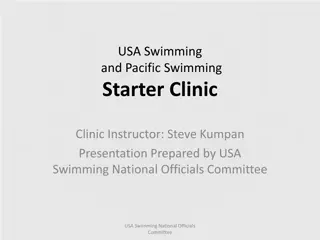USA Swimming Stroke and Turn Judge Clinic Overview
Clinic introduces the philosophy of officiating in swimming, emphasizing adherence to rules, teamwork, professionalism in self-presentation, and conduct expectations. Topics covered include rules, expectations, certification pursuance, and more. Participants learn about the role of officials and the importance of consistency, fairness, and respect in officiating swim meets.
Download Presentation

Please find below an Image/Link to download the presentation.
The content on the website is provided AS IS for your information and personal use only. It may not be sold, licensed, or shared on other websites without obtaining consent from the author.If you encounter any issues during the download, it is possible that the publisher has removed the file from their server.
You are allowed to download the files provided on this website for personal or commercial use, subject to the condition that they are used lawfully. All files are the property of their respective owners.
The content on the website is provided AS IS for your information and personal use only. It may not be sold, licensed, or shared on other websites without obtaining consent from the author.
E N D
Presentation Transcript
USA Swimming and [Insert LSC Here] Stroke and Turn Judge Clinic Clinic Instructor: [Insert Name Here] Presentation Prepared by USA Swimming National Officials Committee USA Swimming National Officials Committee
Clinic Overview Introduction Philosophy of Officiating Expectations and Professional Conduct Technical Rules Working a Meet Pursuing Certification Questions USA Swimming National Officials Committee
Philosophy of Officiating Everything is grounded in the rules. The rules determine what is allowed and what is not. - Ugly but legal - Officials are NOT coaches Observers, not inspectors Observation should be consistent for all rules and all swimmers Do NOT infer or extrapolate Swimmer ALWAYS gets the benefit of the doubt USA Swimming National Officials Committee
Teamwork Meet Referee is in charge, assisted by Deck Referees and Chief Judges Cooperate and respect all at all times Accept assignment without complaint Answer questions from Referees and Chief Judges honestly and with as much detail as possible Follow established relief protocols USA Swimming National Officials Committee
Uniform and Self-Presentation Uniform Requirements - [Khaki or Navy] pants or knee-length shorts or skirt - White polo shirt, tucked in - Belt - Primarily white tennis shoes - White socks - Credential and/or nametag Look professional at all times! USA Swimming National Officials Committee
Conduct Expectations Maintain positive attitude at all times No cell phone usage on deck Do not cheer for or coach swimmers Control emotions on deck Do not discuss calls with anyone other than Referees or Chief Judges unless asked Smile! USA Swimming National Officials Committee
Definitions Arm That part of the body that extends from the shoulder to the wrist Body The torso, including the shoulders and hips Finish The instant that a swimmer touches the wall at the end of the prescribed distance Horizontal Parallel to the surface of the water May Permissive, not mandatory USA Swimming National Officials Committee
Definitions On the Back Position of the body when the shoulders are at or past vertical towards the back On the Breast Position of the body when the shoulders are at or past vertical towards the breast Propulsive Having the power to propel Scissor Kick Use of the top of the instep of one foot and the bottom of the other foot in the propulsive part of the kick Shall Mandatory USA Swimming National Officials Committee
Definitions Simultaneously Occurring at the same time Touch Contact with the end of the course Turn A point where the swimmers reverse or change direction Vertical Perpendicular to the water surface Wall Vertical portion of the pool, contiguous surfaces of the deck and overflow gutter, the front portion of the starting block or platform, or the touchpad at the end of the course USA Swimming National Officials Committee
Technical Rules Freestyle Backstroke Butterfly Breaststroke Individual Medley Relays USA Swimming National Officials Committee
Technical Rules- Freestyle Start Forward start. Stroke/Kick Any style may be used. Must break surface throughout the race except swimmer may be submerged after start and each turn not more than 15 meters where head must break surface. Turns/Finish Some part of swimmer must touch the wall at completion of each length or required distance. USA Swimming National Officials Committee
Common Infractions- Freestyle Head did not break surface of water by 15 meter mark Walking on/springing from bottom No touch at turn USA Swimming National Officials Committee
Technical Rules- Backstroke Start In water facing start end with both hands on gutter or starting grips. A) Guttered pool- Feet/toes may be above the water, but may not be in, on, above lip, or bent over the gutter at any time before or after start. B) Flat wall pads- Feet/toes may be placed above the water level. C) When using backstroke ledges- The toes of both feet must be in contact with the wall Stroke/Kick Any style as long as swimmer remains on the back. Must break surface throughout the race except swimmer may be submerged after start and each turn not more than 15 meters where head must break surface. USA Swimming National Officials Committee
Technical Rules- Backstroke Turns During turn swimmer may go past vertical to the breast and may utilize a continuous single or continuous simultaneous double arm pull to initiate the turn. Some part of the swimmer must touch the wall at the completion of each length. Shoulders at or past vertical toward back when feet leave wall. Finish Some part of swimmer must touch the wall while on the back. USA Swimming National Officials Committee
Common Infractions- Backstroke Toes above lip of gutter after start Head did not break surface of water by 15 meter mark Shoulders past vertical towards breast Delay initiating arm pull Delay initiating turn Re-submerged USA Swimming National Officials Committee
Technical Rules- Butterfly Start Forward start Stroke Body kept on breast. Multiple kicks permitted but first arm pull must bring swimmer to the surface. Must break surface throughout the race except swimmer may be submerged after start and each turn not more than 15 meters where head must break surface. Arms, shoulder to wrist, brought forward over water and pulled back simultaneously. USA Swimming National Officials Committee
Technical Rules- Butterfly Kick Simultaneous up and down movement. No alternating, scissors, or breaststroke kicking movements. Turns/Finish Shoulders at or past vertical toward breast when the swimmer leaves the wall. Touch should be made with both hands separated and simultaneous at, above, or below the water surface. USA Swimming National Officials Committee
Common Infractions- Butterfly Head did not break surface of water by 15 meter mark Alternating kick Breaststroke kick Scissors kick Non-simultaneous arms Underwater recovery One hand touch Non-simultaneous touch USA Swimming National Officials Committee
Technical Rules- Breaststroke Start Forward start. Stroke Body kept on breast. Stroke cycle is one arm pull and one leg kick in that order. Simultaneous arm movement in same horizontal plane. After start and each turn one arm stroke may be completely back to legs. Head must break surface at widest part of second pull. Recovery by the hands from the breast-on, under, or over the water. Elbows under water except last stroke before turn or finish. USA Swimming National Officials Committee
Technical Rules- Breaststroke Kick After start and each turn, prior to the first breaststroke kick, a single butterfly kick is permitted. Movement of the legs shall be simultaneous vertically and horizontally. Feet turned out during propulsive part of kick. No alternating, scissors, or butterfly kick, except as stated, is allowed. Turns/Finish Shoulders at or past vertical toward breast when feet leave wall. Touch shall be made with both hands separated and simultaneously at, above, or below the water surface. At the last stroke before the turn and at the finish an arm stroke not followed by a leg kick is permitted. Head may be submerged after the last arm pull prior to the touch, provided it breaks the surface of the water at some point during the last complete or incomplete stroke cycle preceding the touch. USA Swimming National Officials Committee
Common Infractions- Breaststroke Head did not break surface of water by widest part of second stroke Butterfly kick Scissors kick Alternating kick Arms past hipline Arms not in same horizontal plane One hand touch Non-simultaneous touch USA Swimming National Officials Committee
Technical Rules- Individual Medley Start Forward start Stroke/Kick Rules for each stroke apply. Must swim of event distance as prescribed in stroke, in order of Butterfly, Backstroke, Breaststroke, and Freestyle. May not swim in the style of the other three strokes during the freestyle leg. Turns/Finish Intermediate turns conform to the turn rules for the stroke. Transition turns conform to the finish rules for the stroke. USA Swimming National Officials Committee
Common Infractions- Individual Medley Swimming more than of the race in the style of butterfly, backstroke, or breaststroke USA Swimming National Officials Committee
Technical Rules- Relays Freestyle Relay Freestyle rules apply. Each swimmer must swim of distance. Medley Relay Rules pertaining to each stroke apply. Each swimmer must swim of event distance as prescribed stroke, in order of Backstroke, Breaststroke, Butterfly, and Freestyle. May not swim in the style of the other three strokes during the freestyle leg. Takeoffs Swimmer s feet/foot must remain in contact with the starting platform until the incoming swimmer has touched the finish wall or pad. USA Swimming National Officials Committee
Common Infractions- Relays Early takeoff Swimming more than of the race in the style of butterfly, backstroke, or breaststroke (if a medley relay) USA Swimming National Officials Committee
Working a Meet Contact Meet Referee in Advance Stroke Briefing Assignments and Jurisdiction Observation Techniques Reporting Disqualifications USA Swimming National Officials Committee
Pursuing Certification On-Deck Training USA Swimming Non-Athlete Membership Background Check Athlete Protection Training Online Testing USA Swimming National Officials Committee
QUESTIONS? USA Swimming National Officials Committee
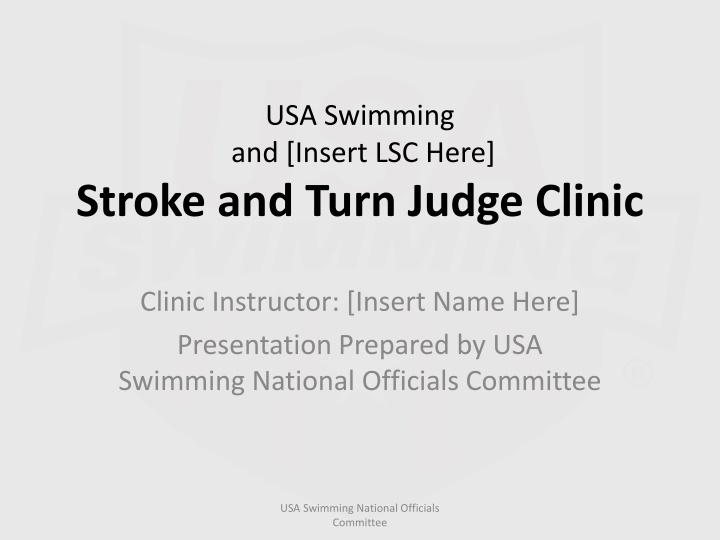

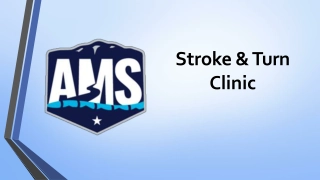

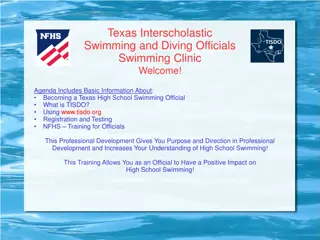
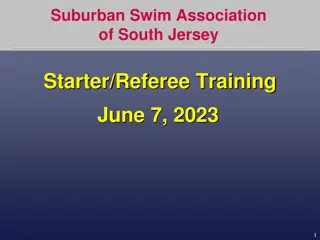
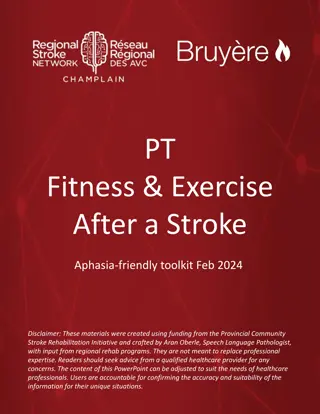

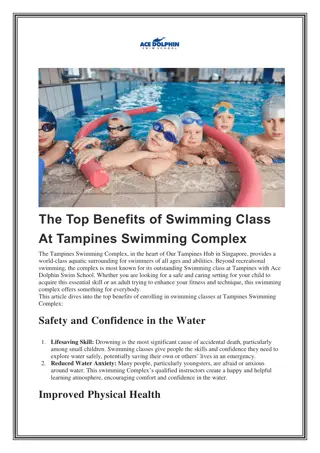



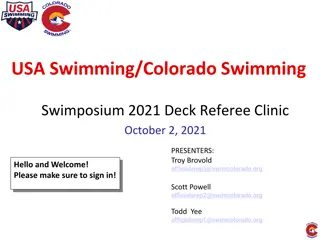
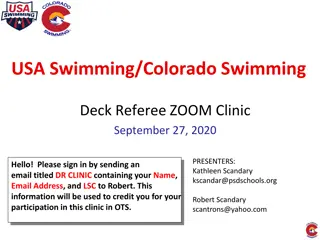
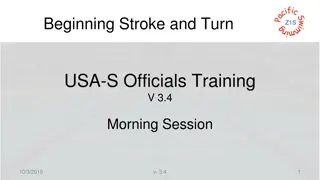
![USA Swimming and [Insert LSC Here] Starter Clinic Overview](/thumb/162824/usa-swimming-and-insert-lsc-here-starter-clinic-overview.jpg)
